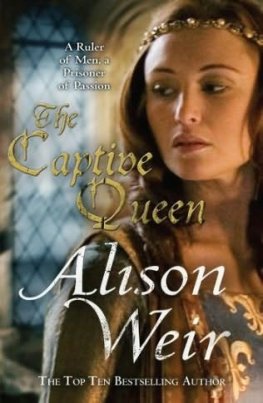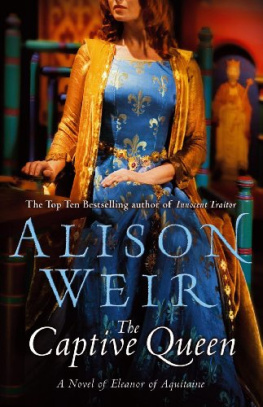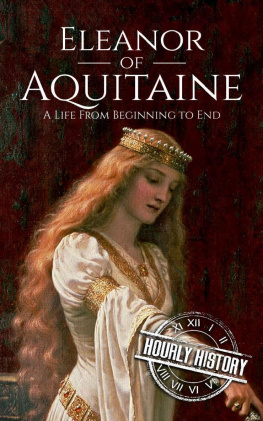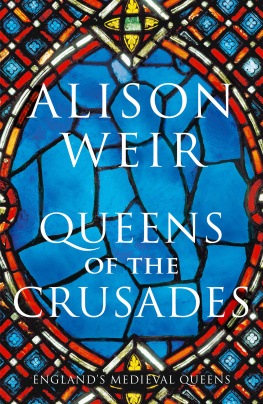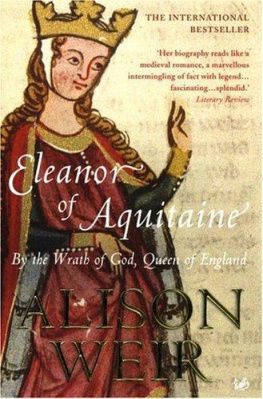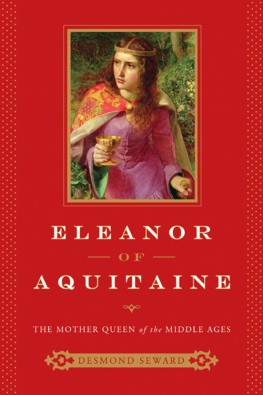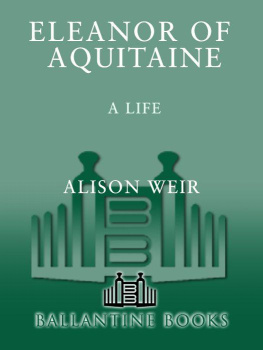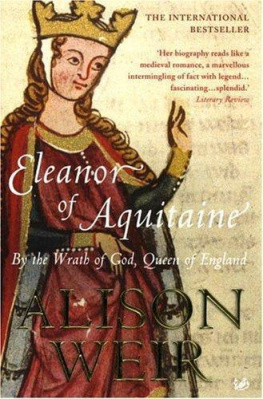Alison Weir - Eleanor Of Aquitaine : By the Wrath of God, Queen of England
Here you can read online Alison Weir - Eleanor Of Aquitaine : By the Wrath of God, Queen of England full text of the book (entire story) in english for free. Download pdf and epub, get meaning, cover and reviews about this ebook. publisher: Pimlico, genre: History. Description of the work, (preface) as well as reviews are available. Best literature library LitArk.com created for fans of good reading and offers a wide selection of genres:
Romance novel
Science fiction
Adventure
Detective
Science
History
Home and family
Prose
Art
Politics
Computer
Non-fiction
Religion
Business
Children
Humor
Choose a favorite category and find really read worthwhile books. Enjoy immersion in the world of imagination, feel the emotions of the characters or learn something new for yourself, make an fascinating discovery.
- Book:Eleanor Of Aquitaine : By the Wrath of God, Queen of England
- Author:
- Publisher:Pimlico
- Genre:
- Rating:5 / 5
- Favourites:Add to favourites
- Your mark:
- 100
- 1
- 2
- 3
- 4
- 5
Eleanor Of Aquitaine : By the Wrath of God, Queen of England: summary, description and annotation
We offer to read an annotation, description, summary or preface (depends on what the author of the book "Eleanor Of Aquitaine : By the Wrath of God, Queen of England" wrote himself). If you haven't found the necessary information about the book — write in the comments, we will try to find it.
Eleanor Of Aquitaine : By the Wrath of God, Queen of England — read online for free the complete book (whole text) full work
Below is the text of the book, divided by pages. System saving the place of the last page read, allows you to conveniently read the book "Eleanor Of Aquitaine : By the Wrath of God, Queen of England" online for free, without having to search again every time where you left off. Put a bookmark, and you can go to the page where you finished reading at any time.
Font size:
Interval:
Bookmark:
Eleanor of Aquitaine
Alison Weir
This book is dedicated with heartfelt thanks to my agent, JULIAN ALEXANDER
and to JILL BLACK who has edited so many of my books.
ACKNOWLEDGMENTS
I should like to extend very special thanks to my editor, Anthony Whittome, for his creative input and his unflagging enthusiasm for this project, and to my commissioning editor, Will Sulkin, for his tremendous support. Gratitude is also due to Lily Richards for her indefatigable picture research.
As always, I must express my thanks to my agent Julian Alexander, without whom this book would not exist: he kept faith with this project for many years before its acceptance. I am grateful also to his former assistant, Kirstan Romano, for all her kindness. Finally, as ever, thank you, Rankin, my husband, and John and Kate, my children, for putting up with me while this book was in preparation. I could never have done it without you.
Contents
Preface xix
Prologue: 18 May 1152 1
1 "Opulent Aquitaine" 3
2 "A Model of Virtue" 21
3 "Counsel of the Devil" 37
4 "To Jerusalem!" 55
5 "A Righteous Annulment" 73
6 "A Happy Issue" 89
7 "All the Business of the Kingdom" 104
8 "Eleanor, by the Grace of God, Queen of England" 120
9 "The King Has Wrought a Miracle" 141
10 "Conjectures Which Grow Day by Day" 158
11 "The Holy Martyr" 177
12 "The Cubs Shall Awake" 189
13 "Beware of Your Wife and Sons" 198
14 "Poor Prisoner" 211
15 "Shame, Shame on a Conquered King!" 231
16 "The Eagle Shall Rejoice in Her Third Nesting" 248
17 "The Admiration of Her Age" 260
18 "The Devil Is Loosed!" 279
19 "The Staff of My Old Age" 300
20 "The Most Reverend Eleanor" 314
21 "The Brood of the Wicked Shall Not Thrive" 326
22 "A Candle Goeth Out" 336
Notes on the Chief Sources 347
Bibliography 355
Notes and References 375
Genealogical Tables 407
Index 423
A Note on Names and Spellings
Different variations of the names of people and places occur in twelfth-century sources. For example, the names Matilda, Maud, and Mahalde are interchangeable, as are Alice, Aaliz, and Alais.
For the sake of clarity, I have used different spellings of the same name to identify different people. Eleanor's daughter is called Alix, Richard Is betrothed of the same name Alys, and the Lord John's betrothed Alice. All are accurate renderings. A similar differentiation has been used with the name Amaury/Aymer/Aimery. Louis VII's daughter, often called Margaret in other works, is here referred to by the French version of her name, Marguerite.
Eleanor, who would have called herself Alienore, is referred to by the more familiar anglicised version of her name.
As in many other history books, William the Marshal is throughout referred to as such, even though he did not acquire his office of Marshal until 1199.
Although Eleanor was Countess of Poitou and Duchess of Aquitaine, I have occasionally used the name Aquitaine as a blanket term covering both her domains, although I have tried to differentiate between them wherever possible.
Many place names have changed since the twelfth century, and where appropriate I have given the modern name in parentheses. Some places no longer exist; wherever possible, I have attempted to discover their exact or approximate location.
Illustrations (not included)
Palais de Justice, Poitiers Roger- Viollet
William IX, Duke of Aquitaine. Manuscript illumination, fr. 12473 fol. 128 Bibliotheque Nationale, Paris
Louis VII, King of France. Manuscript illumination from "Grands Chroniques de France," fr. 2813 fol. 223 Bibliotheque Nationale, Paris
Rock crystal vase, 12th c, from the Abbey of Saint-Denis, now in the Louvre Reunion des Musees Nationaux-- Daniel Amaudet
Retable of St. Bernard of Clairvaux (detail), anon., 12th c, Museo de Mallorca, on loan from the Sociedad Arqueologica Luliana
Count Geoffrey of Anjou. Enamel tombstone, c. 1152, Musee de Tesse, Le Mans Giraudon
Eleanor's seal, from a charter in the Archives de France Atelier de photographic du Centre historique des Archives nationales, Paris
Engaged capital, thought to portray Henry II and Eleanor of Aquitaine. The Metropolitan Museum of Art, The Cloisters Collection, 1934 (34.115.4ab)
Tomb of Matilda, daughter of Henry II, and Henry the Lion, Duke of Saxony, Brunswick Cathedral, late 12th c. AKG London
Effigy of Henry the Young King (detail), late 12th c, Rouen Cathedral Roger-Viollet
Effigy of Henry II (detail), late 12th c, Fontevrault Abbey AKG London
Effigy of Richard I (detail), 1199-1200, Fontevrault Abbey AKG London
Effigy of Berengaria of Navarre (detail), after 1230, Le Mans Cathedral Geoffrey Wheeler
Effigy of King John (detail), c. 1225-1230, Worcester Cathedral Geoffrey Wheeler
Mural from Sainte-Radegonde, Chinon, c. 1196 By courtesy of Les Amis du Vieux Chinon
Effigy of Isabella of Angouleme (detail), mid 13th c, Fontevrault Abbey Geoffrey Wheeler
Effigy of Eleanor of Aquitaine (detail), c. 1204, Fontevrault Abbey AKG London
The tombs of the Plantagenets in the Abbey of Fontevrault Bildarchiv Foto Marburg
Maps
The Angevin Empire in 1154 xv
Europe and the Holy Land in the Twelfth Century xvi
England in the Twelfth Century xviii
[map of the Angevin Empire in 1154 removed]
[map of Europe and the Holy Land in the Twelfth Century removed]
[map of Richard I's route during the Third Crusade, 1190-1194 removed]
[map of Eleanor's journey, 1190-1191 removed]
[map of England in the Twelfth Century removed]
Preface
When, after completing several books on the late mediaeval and Tudor periods, I suggested writing a biography of Eleanor of Aquitaine, it was put to me that it would be impossible for a biographer to do justice to a woman who lived eight centuries ago: that so few of her utterances or letters have come down to us that I would never be able to bring her to life as a real person to whom my readers could relate.
It was a valid point, because for the earlier mediaeval period, the sources that so vividly illuminate the characters of the Tudors-- diplomatic reports, letters, memoirs, diaries, biographies-- rarely survive. And there is a perception, common among those who are more familiar with the later period, that such monkish chronicles as we do have are mostly credulous, biased, and ill informed. In some cases, this is indeed so, particularly in respect of the period covering the early years of Henry II's reign, for which there is a paucity of contemporary sources; but there are a considerable number of English chronicles of outstanding quality for the latter part of the twelfth century.
The twelfth century in general is readily accessible to us today because it was an age of burgeoning scholarship that is now regarded as the first Renaissance, an age that gave birth to a succession of outstanding and perceptive chroniclers, whose relatively objective accounts of the personalities and events of their times document a wealth of facts, detail, and contemporary opinion.
Many of these writers were eyewitnesses to the events they described; most were well-educated, intelligent men, who were familiar with the court and the great figures of their age. From the pages of their chronicles, as well as from other surviving records, it is possible to garner a considerable amount of material on Eleanor. It is true that there is a lot we still do not know about her-- for example, no description of her appearance survives-- and that monkish chroniclers in general did not consider women, even queens, sufficiently important to merit much space in their works; but her deeds speak for themselves, as do her surviving charters and letters. I make no apology for quoting two of those letters at length, as they give such insights into Eleanor's character, as well as her state of mind at the time they were written.
Next pageFont size:
Interval:
Bookmark:
Similar books «Eleanor Of Aquitaine : By the Wrath of God, Queen of England»
Look at similar books to Eleanor Of Aquitaine : By the Wrath of God, Queen of England. We have selected literature similar in name and meaning in the hope of providing readers with more options to find new, interesting, not yet read works.
Discussion, reviews of the book Eleanor Of Aquitaine : By the Wrath of God, Queen of England and just readers' own opinions. Leave your comments, write what you think about the work, its meaning or the main characters. Specify what exactly you liked and what you didn't like, and why you think so.




